Hold your VR controllers with a relaxed, cupping grip rather than death-gripping them like they’ll escape. Keep your palms slightly upward-facing and wrists aligned straight with your forearms to prevent strain. Rest your index fingers lightly on triggers and buttons until needed, maintaining loose contact throughout gameplay. Take regular breaks every hour to stretch your hands and wrists. Adjust controller sensitivity settings to match your hand size and grip strength for ideal comfort during extended sessions.
Understanding Natural Hand Positioning for VR Controllers
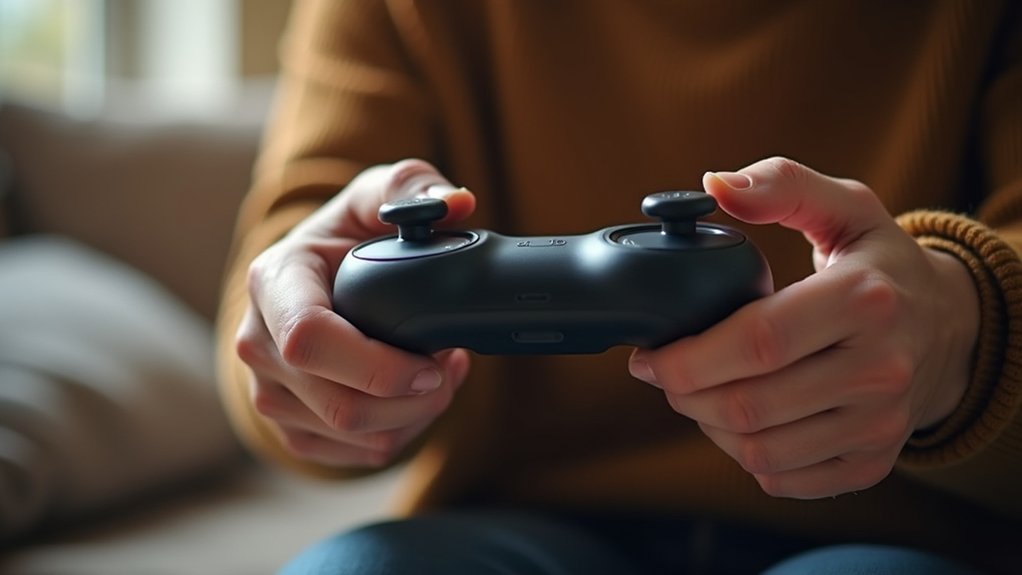
Proper hand positioning forms the foundation of comfortable VR gaming sessions. When you’re gripping VR controllers, focus on natural hand positioning by keeping your palms slightly turned upward. This prevents excessive inward rotation and promotes a more relaxed stance.
Natural hand positioning with palms slightly upward creates the foundation for comfortable, strain-free VR gaming sessions.
You’ll want to adopt a looser grip rather than squeezing tightly, which greatly reduces hand fatigue during extended play sessions.
Position your hands in a cupping manner instead of forming claw-like grips around the controllers. This technique alleviates strain on your fingers and palms.
Keep your index fingers resting comfortably over buttons and triggers until you actually need them, maintaining a relaxed hand position throughout gameplay.
Proper Grip Techniques to Prevent Fatigue
Building on these natural positioning principles, you’ll find that cradling your VR controllers rather than gripping them tightly makes the biggest difference in preventing fatigue.
These proper grip techniques focus on minimizing unnecessary tension throughout your hands and fingers.
Keep your palms slightly turned upward in a natural cupping position, avoiding the cramped claw grip that causes discomfort.
Rest your index fingers lightly on triggers and bumpers until you need them, which helps reduce strain on your joints.
Remember that excessive force isn’t required for button presses or trackpad navigation.
Experiment with a looser grip overall, as this simple adjustment can dramatically enhance comfort during extended sessions.
Give yourself time to adapt to each controller’s unique design—with practice, you’ll develop muscle memory that naturally prevents fatigue.
Wrist Alignment and Strain Prevention Methods
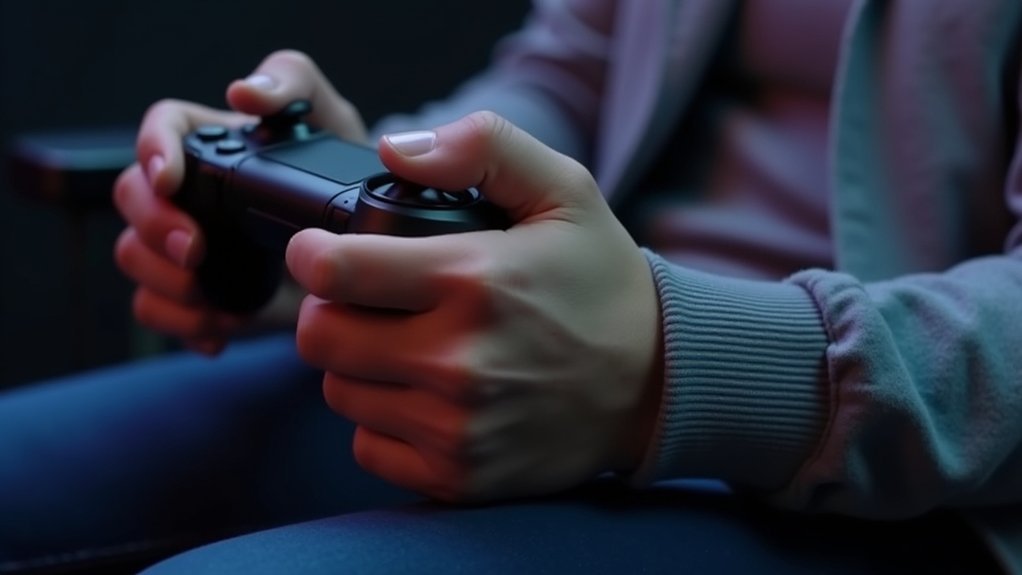
Your wrist position plays an essential role in preventing discomfort during extended gaming sessions.
You’ll want to keep your wrists in a natural, straight alignment rather than bending them at extreme angles that create unnecessary tension.
Adjusting your hand angle on the controller helps you maintain this neutral position while keeping your grip relaxed and comfortable.
Natural Wrist Position
Beyond comfortable seating and proper lighting, natural wrist positioning forms the foundation of sustainable gaming sessions.
You’ll want to keep your wrists straight and aligned with your forearms, avoiding any bending or twisting that creates unnecessary tension. This natural wrist position prevents strain during extended play and reduces your risk of repetitive strain injuries.
Adopt a looser grip on your controller rather than gripping tightly. This relaxed hold alleviates pressure on your wrists while maintaining full control over gameplay.
Position your controller at a height where your wrists can rest neutrally without forcing awkward angles.
Don’t forget to take regular breaks every hour to stretch your wrists and hands, promoting blood flow and preventing stiffness from developing.
Avoiding Tension Buildup
Tension buildup occurs when you maintain awkward hand positions or grip your controller too tightly for extended periods.
This creates unnecessary stress on your muscles and joints, leading to discomfort and potential injury. A looser grip considerably reduces this tension while maintaining control precision.
To prevent wrist strain and tension accumulation:
- Relax your grip – Hold the controller firmly but not tightly, allowing natural hand movement
- Take regular breaks every 30-45 minutes to stretch and reset your positioning
- Avoid claw gripping – Keep fingers naturally curved rather than rigidly positioned
- Shift positions periodically to prevent muscle stiffness and promote blood circulation
Hand Angle Adjustment
Since proper wrist alignment forms the foundation of comfortable controller handling, you’ll want to position your hands with palms slightly angled upward rather than forcing them into unnatural positions.
This natural hand angle adjustment prevents excessive inward twisting that causes wrist strain during extended gaming sessions.
Don’t grip the controller tightly—instead, cradle it loosely to maintain better wrist mobility and enhance comfort.
Each gamer’s anatomy differs, so experiment with various hand angles and grips until you discover what works best for you. What feels natural for one person might create strain for another.
Remember to take regular breaks for wrist and hand stretches.
These brief pauses help alleviate accumulated tension and keep your gaming sessions comfortable and enjoyable.
Finger Placement for Optimal Button Access
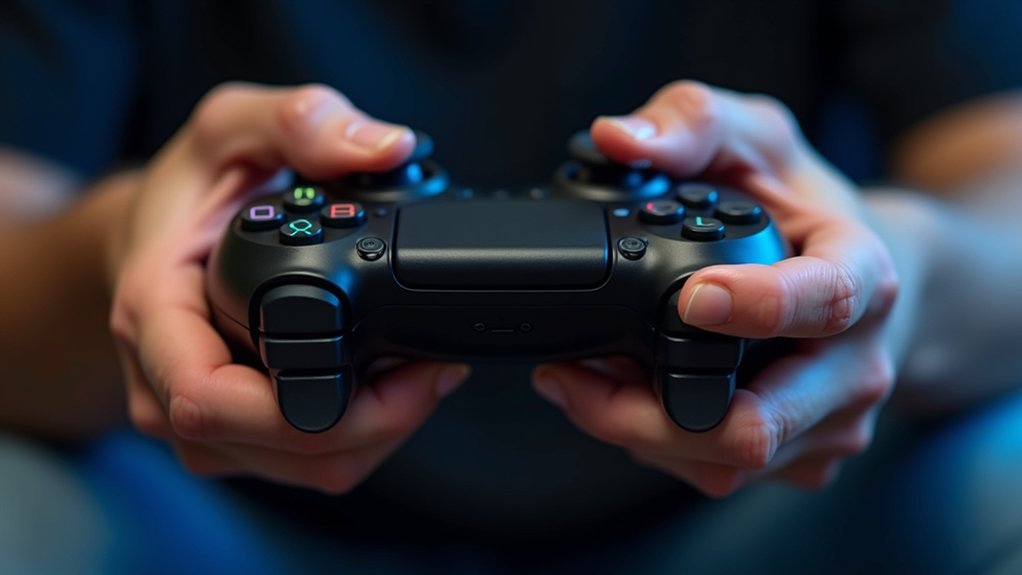
Proper finger placement forms the foundation of comfortable controller handling and directly impacts your gaming performance. You’ll achieve maximum comfort by positioning your fingers strategically across the controller’s surface, ensuring efficient button access without compromising your natural hand posture.
Strategic finger positioning across your controller creates the foundation for enhanced gaming performance while maintaining natural, comfortable hand posture throughout extended play sessions.
Consider these essential finger placement techniques:
- Position your index fingers over triggers and bumpers, keeping them relaxed until needed for quick activation.
- Cup the controller naturally while avoiding claw grip positions that create unnecessary tension and strain.
- Keep your palms slightly upward-facing to reduce fatigue during extended gaming sessions.
- Experiment with different trackpad and button configurations to discover what works best for your hands.
Remember to regularly reassess your finger placement as you adapt. Small adjustments can dramatically improve both comfort and responsiveness.
Adjusting Controller Settings for Hand Size
You’ll need to measure your hand size to determine which controller adjustments will work best for your comfort.
Start by measuring from your wrist to your middle fingertip, then assess the span between your thumb and pinky when stretched.
These measurements help you customize control layouts and sensitivity settings that match your specific hand dimensions rather than using default configurations.
Hand Size Measurements
Most gamers overlook the importance of measuring their hands before selecting or configuring a controller, yet this simple step can dramatically improve comfort during extended gaming sessions.
Taking accurate hand size measurements guarantees you’ll choose a controller with appropriate grip width and ergonomic features that match your anatomy.
To measure your hands effectively:
- Length measurement: Use a ruler to measure from your wrist to your middle fingertip
- Width measurement: Measure across your palm at its widest point, typically below your fingers
- Span assessment: Stretch your hand and measure from thumb tip to pinky tip
- Finger reach test: Note how far you can comfortably stretch without strain
These measurements help you identify controllers that won’t cause cramping or require excessive stretching during gameplay.
Customizable Control Layouts
Once you’ve determined your hand measurements, customizable control layouts become your most powerful tool for achieving ideal comfort.
You can remap controls to place frequently used buttons within easier reach, preventing strain during extended gaming sessions. Gaming controllers like the Steam Controller offer extensive customization options that accommodate different hand sizes and grip styles.
Start by moving essential functions to more accessible locations. If you have smaller hands, relocate jump or sprint commands to buttons you can press without stretching.
Adjust analog stick and trigger sensitivity settings to match your natural grip strength and movement range.
This ergonomic experience improves through regular fine-tuning. Revisit your settings periodically as you discover what works best for your unique hand configuration and gaming preferences.
Transitioning Between Different VR Controller Types
When switching between different VR controller types, your hands need time to adapt to new shapes, button layouts, and weight distributions that can feel foreign after extended use with your previous device.
Adapting between different VR controller types requires patience as your muscle memory adjusts to unfamiliar hardware.
Master these essential grip techniques and hand positioning strategies:
- Loosen your grip – Cradle controllers gently rather than squeezing tightly to prevent hand fatigue during extended sessions.
- Maintain natural palm positioning – Keep palms slightly upward and avoid claw grips for comfortable hand cupping.
- Optimize finger placement – Use index fingers for triggers and bumpers while letting remaining fingers rest naturally.
- Start with slower games – Practice with calm experiences before tackling fast-paced VR content to build controller familiarity.
Recognizing and Addressing Early Discomfort Signs
Your body sends clear warning signals that shouldn’t be ignored during VR gaming sessions. Pay attention to initial soreness or fatigue in your hands, as this indicates your grip or positioning needs adjustment.
If you feel pressing or pinching in your palms, loosen your grip and adopt a relaxed cupping position to reduce pressure.
Take frequent breaks during extended sessions, allowing your hands to recover and adapt to the controller’s design. This is especially important when shifting to new controllers.
Experiment with different hand positions—try cradling rather than gripping tightly to find what works for your hand shape and size.
Remember that discomfort often diminishes with practice and familiarity, so give yourself time to acclimate to your controller’s unique ergonomics.
Building Muscle Memory for Comfortable Extended Play
Building comfortable muscle memory takes consistent practice and patience with your VR controllers. Your hands need time to naturally adapt to each controller’s unique design and button layout. Start with shorter sessions and gradually extend your playtime to avoid overwhelming your grip muscles.
Building comfortable VR muscle memory requires consistent practice and patience as your hands naturally adapt to each controller’s unique design.
Developing effective muscle memory for extended play requires strategic practice:
- Practice different grip styles – Try relaxed holds versus claw grips to find what works best for your hand size.
- Maintain loose, natural positioning – Avoid death-gripping controllers as tension creates fatigue faster.
- Take regular micro-breaks – Brief pauses during gaming sessions help reinforce comfortable habits.
- Focus on consistent hand placement – Repetitive correct positioning builds lasting muscle memory.
Building muscle memory isn’t rushed. Allow your hands to develop familiarity gradually, and you’ll enjoy comfortable extended play sessions without strain or discomfort.
Frequently Asked Questions
What’s the Best Way to Hold a Controller?
You’ll want to maintain a loose grip with palms slightly upward, avoiding claw positioning. Rest your index fingers over triggers until needed, and prioritize finding a personal grip that matches your hand size.
How Do I Hold My Controller for Better Aim?
You’ll improve your aim by positioning your palms slightly upward for a relaxed grip. Keep your index fingers ready on triggers, experiment with looser grip pressure, and adjust based on your hand size for ideal precision.
What Is the Best Way to Hold a Controller for FIFA?
You’ll want a relaxed grip with palms slightly upward and fingers resting on triggers. Use a claw grip for better face button access while maintaining analog stick control for quicker reactions.
How Do I Make My Controller Vibrate Constantly?
You’ll access your game’s settings menu and find vibration or rumble options to enable continuous feedback. Alternatively, use third-party software like Steam’s Big Picture Mode to customize constant vibration settings.

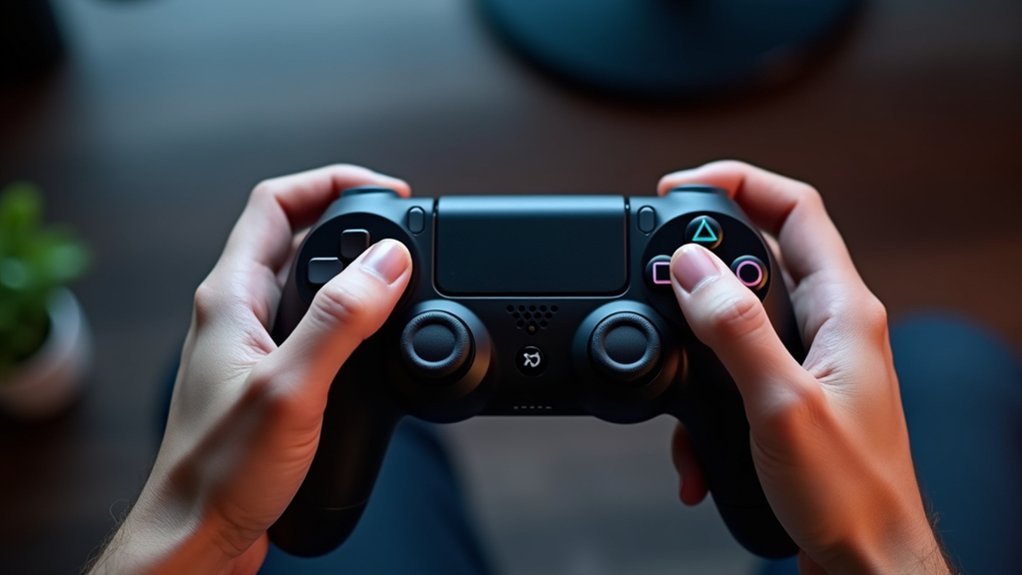
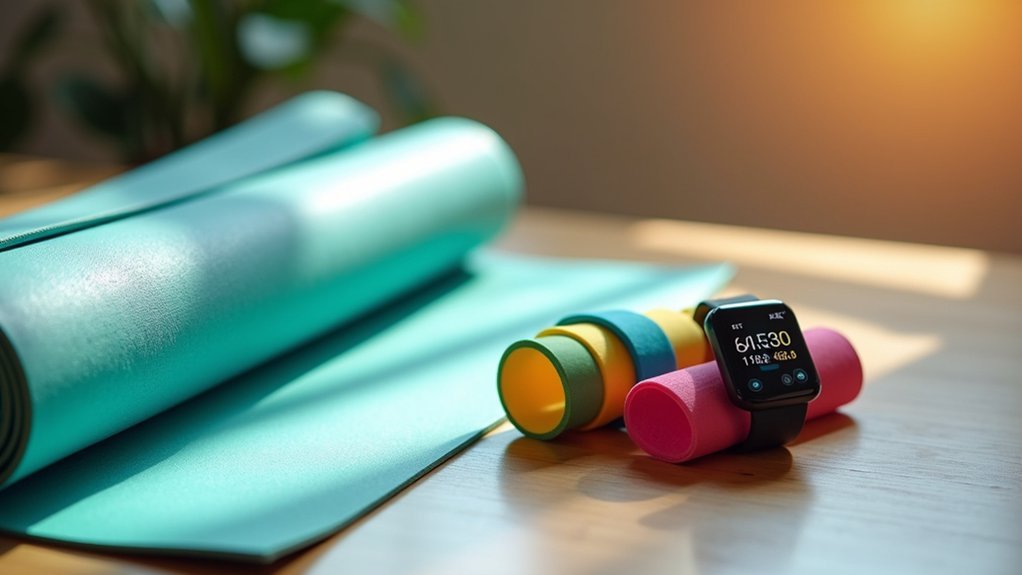
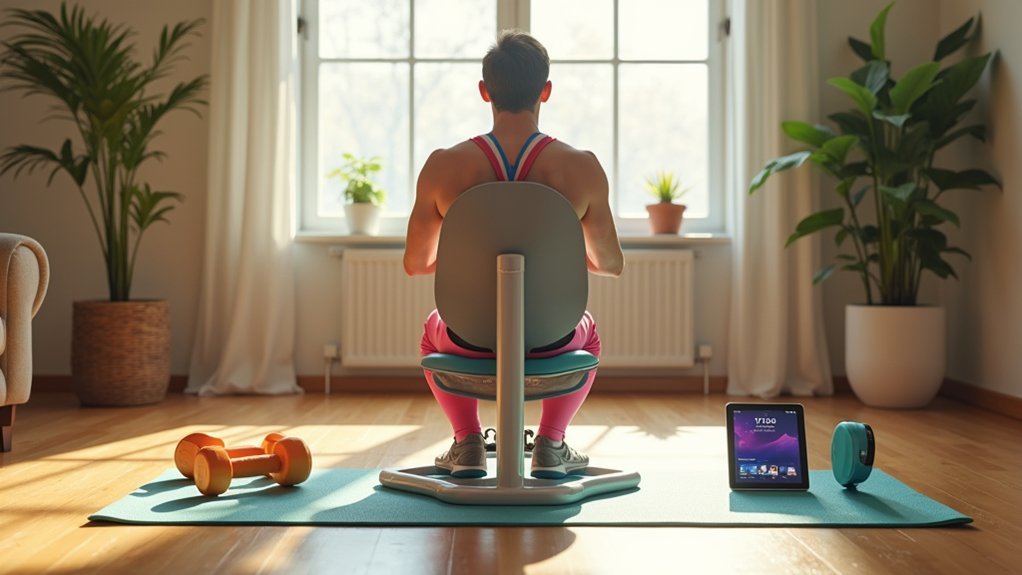

Leave a Reply